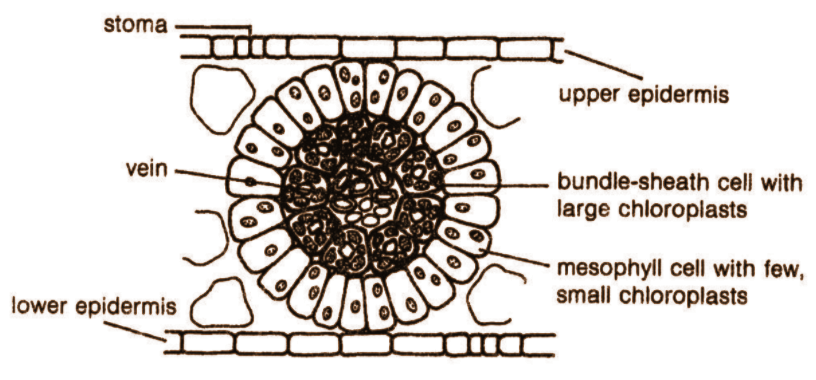
What is Kranz anatomy? Write a note on photosynthesis of those plants in which this anatomy is found.
Answer
502.5k+ views
Hint: The term kranz is also called wreath or ring, and it is the specialized structure in
Complete answer:
Kranz anatomy is mainly formed in three different steps
- The Initiation of procambium occurs.
- There is a specification of the bundle sheath and mesophyll cells.
- Chloroplast development and integration of the
Photosynthesis in Kranz anatomy
- In these plants, light-dependent reactions occur in mesophyll cells, while dark reactions occur in bundle sheath cells.
- In the
- Later this oxaloacetate is converted to Malate and it enters the bundle sheaths and in bundle sheaths, malate dissociation occurs, which releases the carbon dioxide.
- Rubisco fixes the carbon dioxide, which converts to sugar
- The mesophyll cells constantly pump the carbon dioxide to the bundle sheath cells, and so carbon dioxide concentration is always high around the rubisco, which reduces photorespiration.
- The majority of the plants convert the carbon dioxide into 3 carbon compounds by the enzyme Rubisco, if this enzyme catalyses the reaction with oxygen, it induces the process of respiration.

Note: In
Complete answer:
Kranz anatomy is mainly formed in three different steps
- The Initiation of procambium occurs.
- There is a specification of the bundle sheath and mesophyll cells.
- Chloroplast development and integration of the
Photosynthesis in Kranz anatomy
- In these plants, light-dependent reactions occur in mesophyll cells, while dark reactions occur in bundle sheath cells.
- In the
- Later this oxaloacetate is converted to Malate and it enters the bundle sheaths and in bundle sheaths, malate dissociation occurs, which releases the carbon dioxide.
- Rubisco fixes the carbon dioxide, which converts to sugar
- The mesophyll cells constantly pump the carbon dioxide to the bundle sheath cells, and so carbon dioxide concentration is always high around the rubisco, which reduces photorespiration.
- The majority of the plants convert the carbon dioxide into 3 carbon compounds by the enzyme Rubisco, if this enzyme catalyses the reaction with oxygen, it induces the process of respiration.

Note: In
Recently Updated Pages
Master Class 11 Economics: Engaging Questions & Answers for Success

Master Class 11 Business Studies: Engaging Questions & Answers for Success

Master Class 11 Accountancy: Engaging Questions & Answers for Success

Master Class 11 English: Engaging Questions & Answers for Success

Master Class 11 Computer Science: Engaging Questions & Answers for Success

Master Class 11 Maths: Engaging Questions & Answers for Success

Trending doubts
Which one is a true fish A Jellyfish B Starfish C Dogfish class 11 biology CBSE

State and prove Bernoullis theorem class 11 physics CBSE

1 ton equals to A 100 kg B 1000 kg C 10 kg D 10000 class 11 physics CBSE

In which part of the body the blood is purified oxygenation class 11 biology CBSE

One Metric ton is equal to kg A 10000 B 1000 C 100 class 11 physics CBSE

Difference Between Prokaryotic Cells and Eukaryotic Cells




